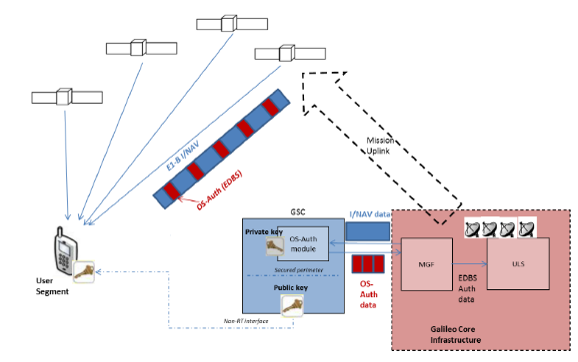The European Space Agency officially announced testing of Galileo’s Open Service Navigation Message Authentication (OSNMA) in its signal-in-space, allowing the first OSNMA-protected position fix to be successfully computed. This is the first-ever transmission of authentication features in open signals of a GNSS. Testing has been underway since November 18, 2020.
OSNMA test signals are broadcast by the Galileo constellation using the spare bits from the current navigation message, therefore not impacting the legacy OS receivers implementing the current OS Signal-In-Space Interface Control Document (OS SIS ICD). Testing will continue over the next months, leading to a public observation phase.
[Photo: European Space Research and Technology Centre (ESTEC), in Noordwijk, the Netherlands. Courtesy ESA.]

The Galileo OSNMA allows GNSS receivers to verify the authenticity of GNSS information, making sure that the data they receive are indeed from Galileo and have not been modified in any way. Its structure and functioning was generally described in the GNSS Solutions January 2018 column of Inside GNSS magazine, and further elaborated in a February 2020 article.
On November 18, 2020, Galileo satellites started the transmission of authentication data for testing purposes, and some users immediately began testing it once they noticed the signal in their receivers, as reported here. The first tests used eight Galileo satellites for around two hours on that day. Tests have continued since mid-November for intermittent periods, and will continue over the next months.
Upon successful completion of the internal testing phase, a public observation phase will begin, in which the OSNMA signal will be publicly accessible. In preparation of this phase, the OSNMA user Signal-In-Space Interface Control Document (OSNMA SIS ICD), receiver implementation guidelines, and the necessary cryptographic materials will be published. This will allow receiver manufacturers and application developers to test and prepare their products.
During the public observation phase, feedback will be gathered from users, leading to the consolidation of the service.
“Ensuring the validity of positions elaborated by GNSS is one of the main challenges before addressing an entirely new set of applications demanding dependability and resilience. Galileo is now set on course to deliver on this highly anticipated feature and has many more novel features in store for the coming years,” stated Matthias Petschke, Director of Space at the European Commission, DG DEFIS.
“Galileo’s Open Service Navigation Message Authentication is one of its key differentiators. The additional robustness that it will provide to the Galileo signal will be critical for many applications, particularly those where security and trustworthiness are a priority, making the OSNMA a key component in any resilient PNT solution,” said Rodrigo da Costa, Executive Director of the European GNSS Agency.

“Up until now, as a navigation satellite disseminates navigation and timing data, there is no way of confirming these data are indeed coming from their apparent originator. As a result, the data could be falsified, a phenomenon known as spoofing, where corrupt false signals mislead receivers about their position, misleading their users in turn, with potentially serious consequences,” commented Paul Verhoef, Director of Navigation at the European Space Agency.





